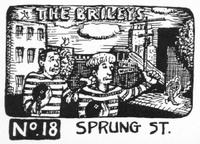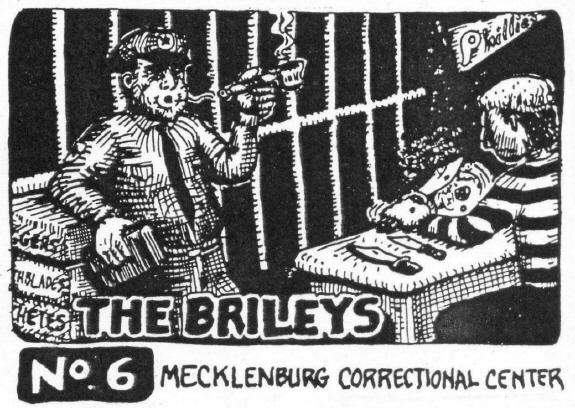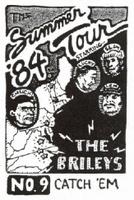Note: In June of 1984, Richmonders experienced an abrupt change in the way mainstream news was gathered and presented. A monster jailbreak story caused that to happen. Because of that change, I stumbled onto an offbeat gimmick in the world of self-publishing. This piece about that episode was first written in 1988 for publication in SLANT. For the online realm, I rewrote it in 2005.
While their four accomplices were rounded up quickly, the brothers Briley remained at large for 19 days. The FBI captured the duo at a picnic adjacent to the garage where they had found work in Philadelphia.
Linwood Briley was subsequently electrocuted in Richmond on Oct. 12, 1984; likewise, James Briley on Apr. 18, 1985.
While the Brileys were on the run the volume and intensity of the media coverage, both local and national, was unprecedented. During that manhunt the Brileys-mania that surrounded it led to stories about them being spotted, simultaneously, in various locations on the East Coast from North Carolina to Canada.
“OK,” I said to a familiar Power Corner Happy Hour group in the Texas-Wisconsin Border Cafe, “if the Briley brothers can be made into heroes, to sell tires and sofas on TV, how long will it be before they're on collectable cards, like baseball cards? (or words to that effect).” To illustrate my point I grabbed a couple of those Border logo-imprinted cardboard coasters from the bar and sketched quick examples on the backs, which got laughs.

Traveling around to Fan District bars on my bicycle, it took about three days to sell out the first press-run from my olive drab backpack. New cards were designed, to expand the set to 14 cards. More sets were printed, more plastic bags, more bubble gum.
Reporters started calling me for easy quotes, to fill articles on death penalty issues. That I was opposed to the death penalty seemed to strike some of them as odd. Finding myself in a position to goose a story that was lampooning the overkill presentation of the same press corps that was interviewing me was fun. At first.
Some of them, if not all, had box cutters in their hands; all of them were definitely Black. At that moment I felt Whiter than Ross Mackenzie (then the editorial page editor of the Richmond News Leader). Tension filled the air when their spokesman asked if I was the man behind those cards and T-shirts.
As it was not the first time I’d been subjected to questions about the cards, I promptly asked if any of them had seen the cards. Or, had they only heard about them?
So, I did. She gave me specific details. It was mostly stuff I had known, or suspected, but the way she told it was brutal.
At this point the success of my absurd art project seemed to be turning sour. Then I got a call from a reporter asking me what I had to say about Linwood Briley having made some disparaging remarks about my cards. Well, I got peeved and asked the scribe what the hell anybody ought to care about what such a man has to say.
Rea says he designed the cards to deflate what he saw as the growing mythology of the Brileys, and to lampoon what he viewed as excessive media attention to their exploits. "The cards are deliberately provocative," he said. "I sensed that the Brileys, because of their derring-do, were becoming heroes. People wanted to know everything about them. We had two to three articles in the paper every day down here."Rea drew the first cartoons for friends. When they found them amusing, he decided to market them at $1.50 a pack. "I'm a little uncomfortable that I'm becoming a part of the point I'm making," he said.
About three years later, I was having a beer in the Bamboo Cafe, standing at the bar at Happy Hour talking with friends. A middle-aged man who I didn’t know stepped my way. Furtively, he asked if I was the guy who “drew those Briley cards.”
 After I said, “yes,” and introduced myself, he asked me a few frequently asked questions about the cards. Then he spoke in a hushed tone, saying something like, “What about those missing cards?”
After I said, “yes,” and introduced myself, he asked me a few frequently asked questions about the cards. Then he spoke in a hushed tone, saying something like, “What about those missing cards?”“Missing cards?” I returned, feeling uncomfortable. “Are you asking why I skipped some numbers?
He nodded and reached in his shirt pocket to pull out a full set of The Brileys, with the cards still in the original plastic bag. Wanting to end the conversation quickly -- that he had the cards with him was way too strange for me -- I told him the simple truth with no jokes: “OK. First, I wanted to imply there was a vast series out there, without having to create it. Then, I wanted the viewer to maybe imagine for himself what the other cards might be.”
The collector put the cards back in his pocket. He stepped away, obviously disappointed with my easy answer, which gave him no dripping red meat to savor. As I remember it, he just walked away and didn't say anything else.




No comments:
Post a Comment